It's weird to know that a million people have read the things my team and I have written over the last month. (A million and two if you count my parents.)
That's a ton of unique, human, actual people.
It's even weirder when you consider we're not writing about sexy topics such as celebrity breakups or what happened on “Game of Thrones" last week (no spoilers!).
Instead, we're writing about business-to-business (B2B) software.
B2B software is not sexy.
No matter how hip the nerds of Silicon Valley (both the place and the show) have made tech entrepreneurship, a network monitoring tool will never excite the same passionate fandom as something B2C facing, such as a movie, a piece of consumer tech, or even a beverage.

B2B software is about as sexy as an enterprise server box... (Source)
This means that if you produce B2B content, it's extra hard to make it engaging and to find (let alone grow) a devoted audience.
I know, because as Capterra's content marketing director, I've been there.
Content strategy lessons from Capterra's road to 1 million
When Capterra first started seriously investing in content marketing in late 2013, we had no idea what we were doing—we had blog traffic that could be measured with an eyedropper, a totally unfocused approach to topic selection, and only a vague idea of what metrics to track.
Though we muddled through and eventually started to find things that worked, it was a long, drawn-out process.

Our blog traffic over four years. We got it right—eventually.
The difficulty we had mirrors the vast majority of B2B content producers: The median traffic for the top performing post on most SaaS (software as a service) company blogs is just 77 visits per month.
The median traffic for the bottom 10% of posts? Three. Per month.
The missteps that we made in 2013 are the same that thousands of other companies are making today.
We've gone through five years of fine-tuning our strategy to get it right. In this article I'll share our B2B content marketing strategy and the most important lessons we learned while developing it so you don't have to make the same mistakes we did (you'll be free to make other ones).
Below, I'll lay out the five big things we learned over five years to increase our blog traffic to 1,000,000 visits a month.
Lots of other, awesome folks have already written reams of great content on just this topic, and I encourage you to check them out! This piece will get into some of the less well-covered but hopefully just-as-helpful lessons from our own experience.
Plus “Silicon Valley" gifs.

Wheeee (Source)
Lots of “Silicon Valley" gifs.
Lesson 1: Go all in and hire full-time writers
We had a blog at Capterra well before 2013.
In fact, as a fresh-faced intern, I wrote some of our very first blog posts in 2009. They're still out there. No, I won't link to them.
We had heard that blogging was something businesses should do, so we did it. Kind of. Halfheartedly.
The problem was, the blog got no traffic. It was unfocused, intermittently updated, rarely promoted, and of dubious writing quality.

Traffic in the era of J.P. the intern—not proud of it
The reason? No one owned the blog.
Nominally, it was under the control of marketing. Or was it our CEO, who also seemed to run it? Or the customer service rep who also managed our corporate Twitter account?
People contributed posts whenever they had time and treated the exercise as a secondary responsibility they would get to after all their real work was done.
This problem wasn't fixed until we went all-in on content marketing.
We were finally motivated to do this, frankly, because a competitor of ours (now under the same brand as us) was kicking our butts with content, and we didn't want to get left behind.
Capterra started with two dedicated writers for our blog (me and one other) and soon expanded to three (we're now even bigger).
Full-time writers gave us a competitive advantage in a few ways:
We were able to produce more content: For obvious reasons, a dedicated writer can create more blog posts than someone who's trying to create content in addition to their main job.
We were able to produce better content: Trying to source content from existing employees can ensure good subject-matter expertise, but not all existing employees are good writers. Plus, in-house writers have an advantage over freelancers in that they build subject matter expertise over time.
We were able to plan a coherent strategy: When everyone owns something, no one does. A dedicated team can build (and follow) a single unified vision for your content.
Are full-time writers a significant investment for a small company?
Yes.
But that investment's worth it.
Our content has been responsible for almost a million monthly visitors to Capterra, as well as these other big wins:
SEO gains for our main website: As readers share, discuss, and link to our content and as search engines see how it is interconnected to the rest of our domain, related pages on our site rank better.
Brand building: We've gotten mentions and backlinks in prominent publications such Inc., Entrepreneur, and Time and from well-known digital authorities such as Neil Patel.
New customers: As prospects see our content (or traffic from our content), they reach out to work with us.
Relationships with industry experts and influencers: These have resulted in opportunities to collaborate and tap into other audiences and to speak at conferences.
Directly attributable revenue every month: Traffic from blog posts to conversion pages on our main site generates revenue worth triple the cost of the whole content team.
We didn't know we'd see such success when we first gambled on full-time content writers. It was a calculated bet that, thankfully, paid off

Content marketing stallions: Hire them (Source)
Will you get the same value from going all-in on content?
Your organization has to figure that out for itself, but if our experience is anything to go on, you may be pleasantly surprised.
Ready to make the same leap we did? Here are some tips for hiring effective full-time content writers:
Hire for writing skills and culture fit: Industry or technical knowledge is much easier to learn on the job than are fundamentals such as writing ability or not being a jerk.
Find someone who can write a lot: Our writers create up to three detailed, well-researched blog posts a week, most between 1,500 and 3,000 words. Longer, more detailed, and helpful content is best for SEO, and writers who can create quality content quickly will grow your traffic even more rapidly.
Look for someone who writes on the side: Do they have a secret blog or a fiction passion project? Then they care about writing and would welcome an opportunity to make money doing it.
Once we decided to go all-in and had two full-time writers on staff, we knew it was time for a strategy brainstorm, which takes us to the next lesson learned.
Lesson 2: You need a written content strategy
Our first content strategy document was a two-page Microsoft Word file we threw together after an hourlong brainstorming meeting.
Note: I've put together a bonus resource at the end of this post with this original strategy doc, plus a ton of our other templates, checklists, and processes you can steal.

Nothing like a few timely strategy resources (Source)
The plan was pretty basic, but its fundamentals still guide our strategy today. It was an important exercise for several reasons:
Committing to something written forced us to think through the specifics of our content marketing plan. Why were we doing it? Who were we writing it for? How were we going to get an audience?
Seeing something on paper showed us where the gaps in our thinking were. Our target audience for the previous (unsuccessful) iterations of the blog had been anyone and everyone. We had to get more specific.
An official strategy with timelines and names made it easier for the writers and managers to commit publicly to this bold, new content experiment.
Our content strategy consisted of five main sections:
Goals and how to measure them
Audience
Types of content
Content distribution
Content promotion
There's a lot to cover for each section, and that could be a whole other article in itself, so for now I'll just give you a little high-level overview for each.
GOALS AND HOW TO MEASURE THEM
The most important part of this exercise is making sure you have a handle on the big questions.
Why create content in the first place?
What does success look like, and how do you measure it?
Make sure your goals are specific, as this will make them easier to measure and easier to adjust if, later down the road, you find they're not the right goals after all.
Our initial goal was:
Raise traffic (unique visits) to the blog pages for four categories (membership, church, training, and talent), as well as to the directory pages themselves, as compared to the previous three months and the same three months last year.
It was a pretty low bar, but for us this was still an experiment and hitting this goal gave us the confidence to later aim for longer-term goals such as, “boost brand authority as measured by backlinks and direct traffic" and “reach 1,000,000 monthly sessions on the blog."

Aaaaalmost… (Source)
There are many types of goals a content marketing initiative can aim to achieve, but I would suggest picking from one of the following buckets:
SEO: Raise search rankings, increase organic traffic, and rank for more long-tail keywords.
Brand authority: Build relationships with influencers and industry groups, increase referral traffic from backlinks and shares, increase direct traffic and branded search, and build a following and community on social platforms.
Engagement: Increase comments on posts, increase likes and shares, increase time on page and pages per session, increase conversion rates, and build subscriber numbers.
Notice what's not on the above list? Don't worry, I'll cover monetization in lesson three.
AUDIENCE
Who's going to read your words?
And why are they going to read them?
Taking the time to rough up a simple persona of your ideal reader is invaluable.
Your persona will inform everything, from the types of content you produce to the tone to where and how you distribute it.

A sample persona for our CRM-focused blog
Is this a potential customer, already a customer, or an industry influencer?
What stage are they at in their careers? Are they blog readers or video watchers? Do they prefer mobile or desktop? What are their main pain points?
We used customer interviews and leads data, and then trolled places such as Yahoo Answers, Quora, Answers.com, and the AdWords Keyword Planner to learn as much as we could about our potential audience before ever putting pen to virtual paper.
TYPES OF CONTENT
Having a written content strategy also helped us crystallize a philosophy which has served us well as we've grown:
"We will write evergreen guides/extremely insightful articles that make people think differently about something... which people will bookmark to return to and share with everyone they can. Not necessarily software/tech focused, so long as it is focused on the types of problems our audience has and needs solutions to."
There's the temptation with a lot of content marketing, especially of the B2B variety, to limit yourself to covering only those topics in your wheelhouse—a software company will only write about software, a manufacturing company about factory processes, and a legal firm about contract law.
But, in addition to constraining your content to potentially boring topics and leading to a lot of content focused—consciously or not—on your own product, this kind of limitation misreads your audience. Your audience wants to learn or be entertained, not be advertised to.
Software users, procurement directors, and in-house legal counsel are people, who exist outside the very narrow Venn diagram where their professional life intersects with your product or service.
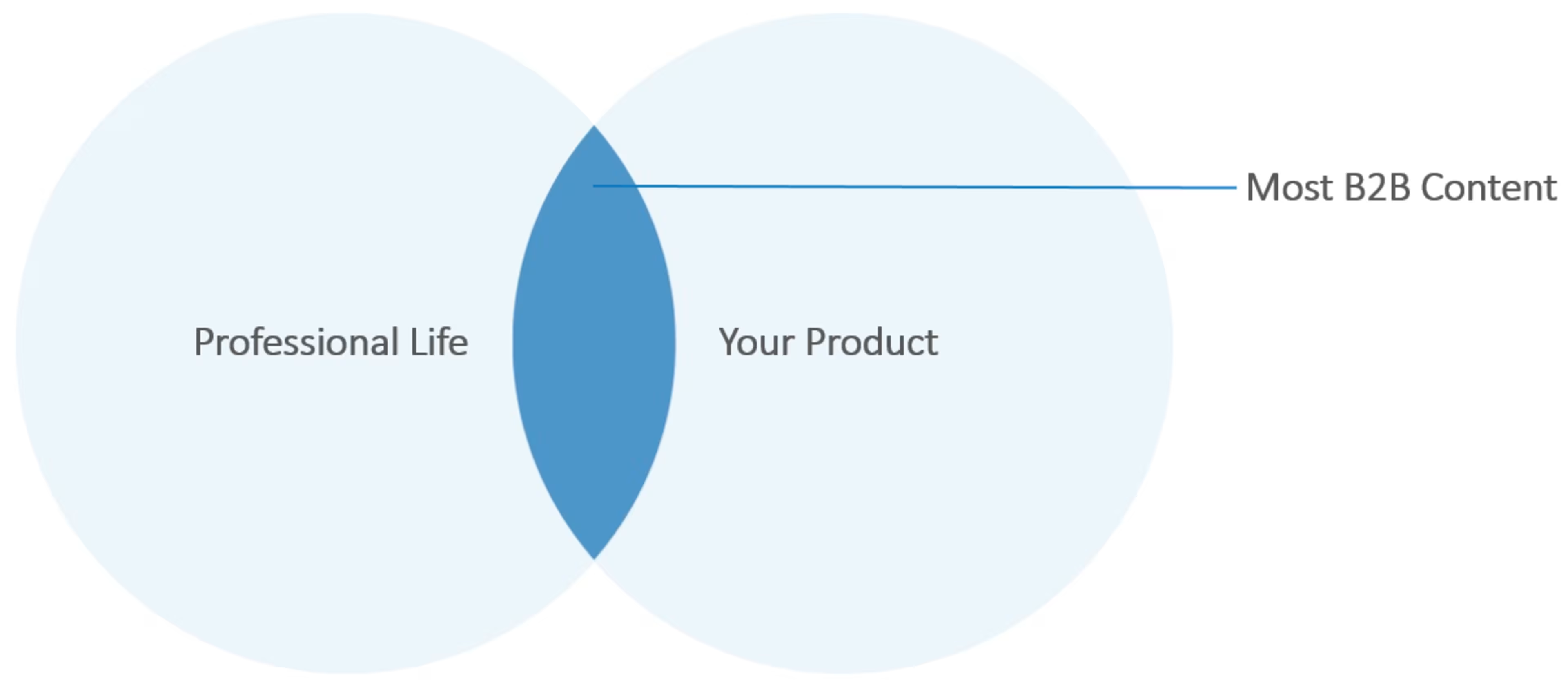
Bad content strategy
To cultivate an audience for the long term, build trust, and cast a wider net, you must provide useful, authoritative, and entertaining content that touches your target reader's entire business life and that helps them be better at all aspects of their job.

Better content strategy
Not only does this capture the attention of more potential readers and customers, it shows you understand their needs and pain points, even the ones your product doesn't address directly.
A field service software company that offers guidance on how to hire and retain great service techs (without just saying their software is the answer) shows they can be trusted in the other areas their product does touch, because clearly they understand the issues a field service manager faces.
One way we've thought about this is by using the traditional marketing funnel and attaching our own definitions and content to each stage.

You'd be surprised how many companies ignore that top stage
In the above image, the “pre" and “top" stages are where we produce a large bulk of our content; not only is there a much bigger audience there, but that content primes the pump for people to trust you and know about you later down the funnel.
CONTENT DISTRIBUTION
Another place where knowing your audience will really help you is deciding where to actually publish content.
We selected three channels to start:
Our blog
Guest posts for other blogs and relevant publications
Email newsletters
Depending on your own audience persona, and the types of content they prefer to consume, you may have more luck with video distributed through YouTube/Vimeo, infographics published on Pinterest, or helpful tools hosted on your own domain.
But don't overdo it.
Pick one main channel and one or two ancillary channels. Content is a long game (see lesson three, below), and if you spread yourself too thin, you won't be able to devote the time and energy to build up the content you need in any one channel.
For us, the startup costs and learning curve were lower with a blog (compared to buying a $2,000 camera to do video correctly), so that's where we started.
CONTENT PROMOTION
“Content promotion is just as important as content creation."
But to guarantee you actually practice it, you need both a written content strategy and a written promotion strategy.
We took the promotion side of content marketing seriously, and, in 2013, along with our two-page written content marketing strategy, also produced a two-page content promotion strategy.
Four total pages of strategy!
Note: I also included this in the big pack of bonus resources at the end of this post, plus all our other templates, checklists, and processes you can steal.
Our promotion strategy answered three main questions:
What content is getting promoted (blog posts, guest posts, infographics)?
Who is promoting it (the writer, someone on the marketing team, or someone else at the company)?
What channels it is getting promoted on (LinkedIn, Twitter, email, forums, other publications' comment sections)?
Based on your own team structure, goals, and industry, you will probably have different answers to each of these questions than we did.
Which is totally OK!
But just to give you a feel for what worked for us, here's how we answered them:
All content gets promoted, but at differing levels. A blog post gets the most basic level—just social and community pushes and email newsletter inclusion. An in-depth research report or infographic gets a lot more love, including added email and social pitches to influencers, industry pubs, and tier one media.
The writer does a minimum level of promotion for each piece through their own channels (15 to 30 minutes a week), but the marketing team handles all the main corporate social accounts and bigger pitches/promotional campaigns.
Note: Our "Writer Promotion Checklist" is also included in the big pack of bonus resources at the end of this post.
We picked three channels to focus on and get really good at before expanding: Twitter, LinkedIn, and email (both email newsletters and emails to influencers).
That last point is important, and you should absolutely limit which channels you promote to at the beginning. Too many companies try to be everywhere and end up spreading themselves too thin instead of really taking the time to master a few high-quality promotion avenues.
But a written strategy isn't enough if you don't have a good idea of how to apply it, which brings me to our next lesson learned.
Lesson 3: Focus on the long term
You're not going to make a million dollars from your content a week after you publish your first piece.
And it would be absurd to think you would, right?
But most of the biggest mistakes I see in content marketing stem from just this type of thinking.
Many managers and CEOs want to see an immediate, direct return on content, despite the mountains of advice telling them they shouldn't.
Our experience has been the opposite, for two big reasons:
Content takes six months to a year to get any traction and start driving real traffic.
A short-term focus on direct ROI distorts your writing and leads to lower quality content. It also ignores content's bigger, more indirect benefits.
Our internal data shows that, on average, traffic to our content doesn't really pick up steam until month five and doesn't peak until 10 months after publication (except for traffic spikes from initial promotion efforts in month one).
Here's a graph showing the average for the first year across newly published posts:
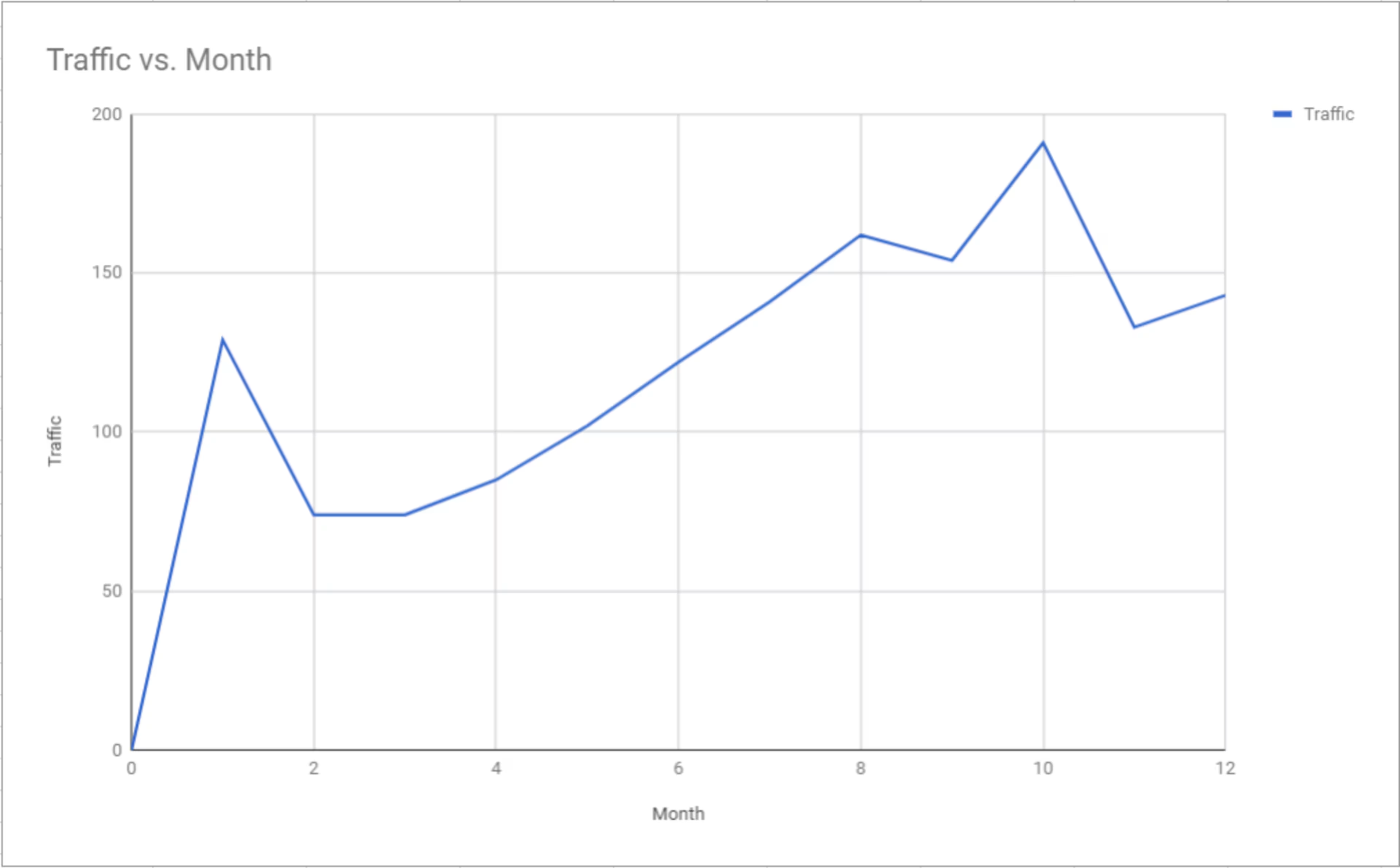
Average traffic for the first year of newly published posts—dat lag time doe
Our top ten highest-performing content pieces across the entire blog were all published at least a year ago, and several are two, or even three years old.
Take our most popular post, which published in June 2014:

Traffic for our most popular post
You can see it's not until months four and five that we really started to get significant traffic from that post.
If you're going into content marketing expecting to have a “viral hit" in month one, or even months two, three, or four, you're going to have a bad time.

Can't always get what you want, especially with content growth (Source)
So if a short-term, revenue-heavy focus is exactly the wrong way to do content marketing, what is the right way?
We've found that creating content with a long-term focus boils down to the following three requirements:
Write for people
Focus on quality
Don't monetize until later
WRITE FOR PEOPLE
This is one of those “no duh" pieces of advice that far too many organizations ignore.
What this means is don't be too keyword- or metric-focused in your content. Instead, write about topics you know your audience is interested in, need help with, and that you can provide honest solutions for.
Then you can optimize for keywords.
A conversational tone—writing how people actually talk—on a topic they care about, will always beat an over-optimized, keyword-stuffed, answer-box-targeted, e-zine quality article in the long run.
And content is a long-run game: Google is constantly working to optimize its algorithm to get the highest-quality content in front of readers.
So focus more on that “quality content" part, and the “getting in front of readers" part will, generally... take care of itself.
FOCUS ON QUALITY
Anyone can say "do this," but great content also says, "and here's how."
Content, especially in the B2B space, has to help readers solve a problem, and any advice needs to be a concrete and actionable “how to." Helpful content is the most important indicator of quality.
Here are the rough rules of thumb I use with our team to ensure each section of a piece is helpful and meaty:
Include links to resources, tools, or platforms that will help the reader do what you are telling them to do (industry-specific is ideal, and try to include resources that you've tested).
Include a sample or template of what you're telling the reader to do.
Include examples or case studies of other organizations that successfully did what you are telling the reader to do.
Include stats/research that back up the importance of doing what you're recommending.
Include your own experience and lessons learned.
DON'T MONETIZE UNTIL LATER
The easiest way to get buried in short-term thinking and to make content mistakes that will hurt you in the long run is trying to monetize too soon.
Even after five years, we still don't consider direct monetization of content as the primary goal.
Beyond some links to related software directory pages (for instance, this one I'm including right now so you can check out some content marketing software) and an affiliate link here or there, we've found the main benefit of content to our business is indirect.
SEO lift, brand building, visibility to new customers, and relationships with industry experts and influencers bring in far more money indirectly to the business than the few hundred thousand a month we could get by stuffing the blog full of ads, paid products, or thinly veiled sales brochures.
And by not being driven by direct monetization, we're able to stay objective and long-term focused, which improves the overall quality of our content.
But we still don't always get it right, which takes us to the next big lesson we learned.
Lesson 4: Test a lot of different things
Ninety percent of your content will be wasted.
And that's a conservative estimate.
If you're familiar with the Pareto Principle (also known as the 80/20 rule) you know that, in general, 80% of your results come from only 20% of your efforts.
In content marketing, that ratio gets even more extreme.
We mirror the vast majority of content organizations, in which 1 to 10% of our content generates 80 to 90% of our results.
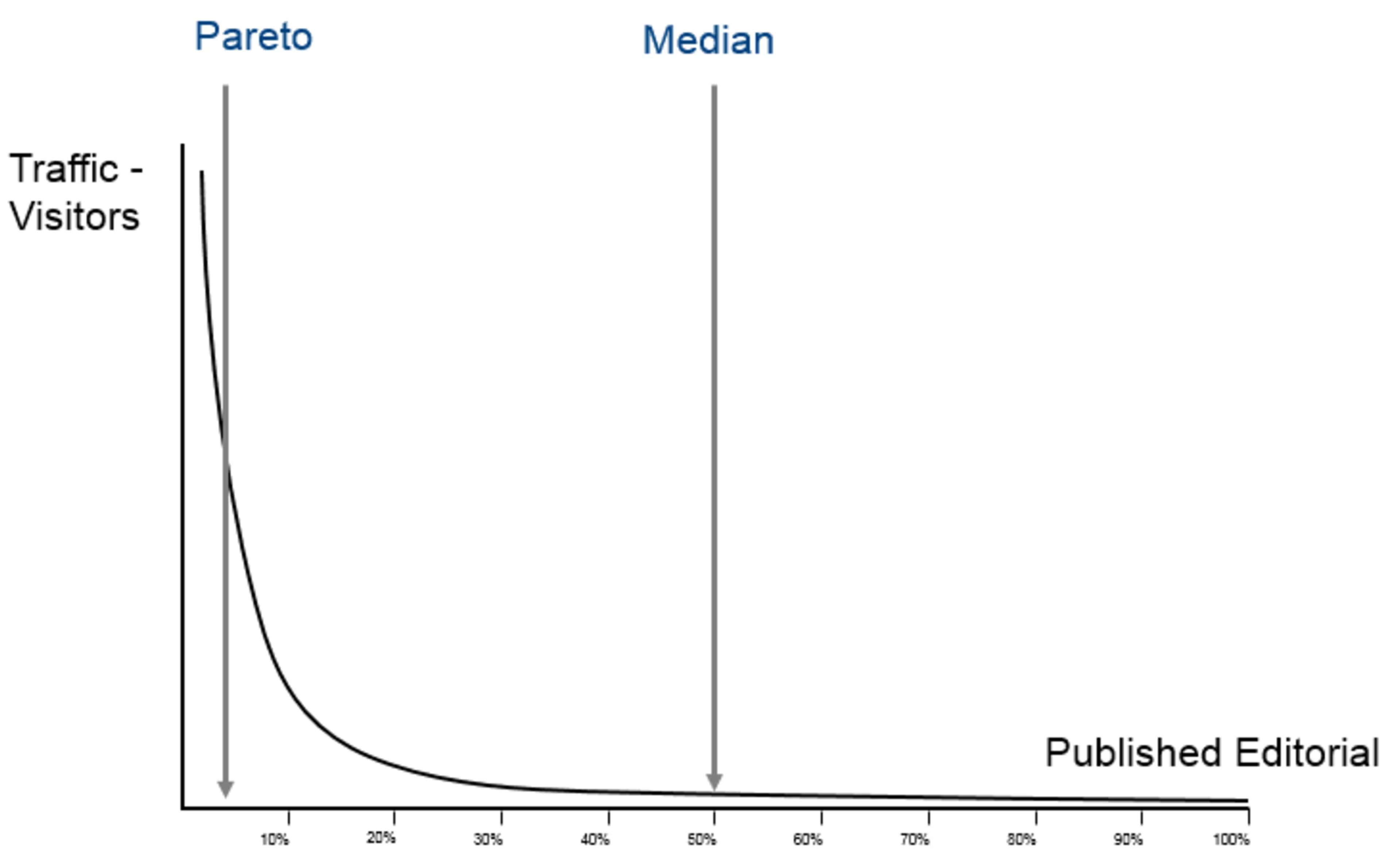
Our content success distribution
The truth is, you don't really know ahead of time which content is going to be a runaway success, and which is going to sink without a trace.
But there are things you can do to try to increase your hit rate.
Here's how we deal with content's hyper-Pareto-ness:
Try a lot of stuff to see what sticks
Scale what sticks across as many places as possible
TRY A LOT OF STUFF
Because you don't really know ahead of time which content will perform the best for your audience, you should aim for a relatively high publishing volume. We do once a week per blog category, or about two to three articles per writer, per week.
This allows you to try a bunch of different content types and topics on your audience to see what really resonates.
Market and competitor research can take you only so far here; to actually know how your content will perform you need to publish it—subtle differences in audience, channel, and even how Google views your domain can impact content performance in ways you can't predict.
Content marketing is thus an organic process of discovery, exploration, and experimentation. There's no mathematical formula for successful content in your niche; you have to feel out what works.
If you follow too regimented a process, researching, planning, and prescribing every little thing, and publishing only when your formula says it's perfect, you will paradoxically reduce your chances of discovering a new "hit" because you'll be publishing less content. (The caveat of course is that standards for content quality should still apply.)

Your rigid content formula won't save you from a more nimble competitor (Source)
The math on this is pretty simple:
[Percent chance of publishing a hit] x [total number of pieces published ]= [total number of hits published]
If you publish fewer pieces, you will have fewer opportunities for any one piece to be a "hit," and so you will likely have fewer total hits.
SCALE WHAT STICKS
Once you've discovered content that resonates with your audience, however, you can capture what works and scale it as much as possible.
We refer to these successful pieces as our “core topics," and we track them in a spreadsheet.
These are content topics that we know perform well across all our blog categories and within a variety of target audiences. Every time we discover a new one within a single category, we add it to the list as a “provisional," roll it out to see how it performs in a few other categories, and then, if all goes well, add it to the list as a full-fledged core topic.
Here's an example:
In 2016, our writer Nick Morpus published a piece titled, “The 10 Books Every Fundraiser Should Read" to our nonprofit blog category.
It did gangbusters for social traffic, shares, and engagement:

He shoots…
So he wrote another one, but targeted at our event management blog category:
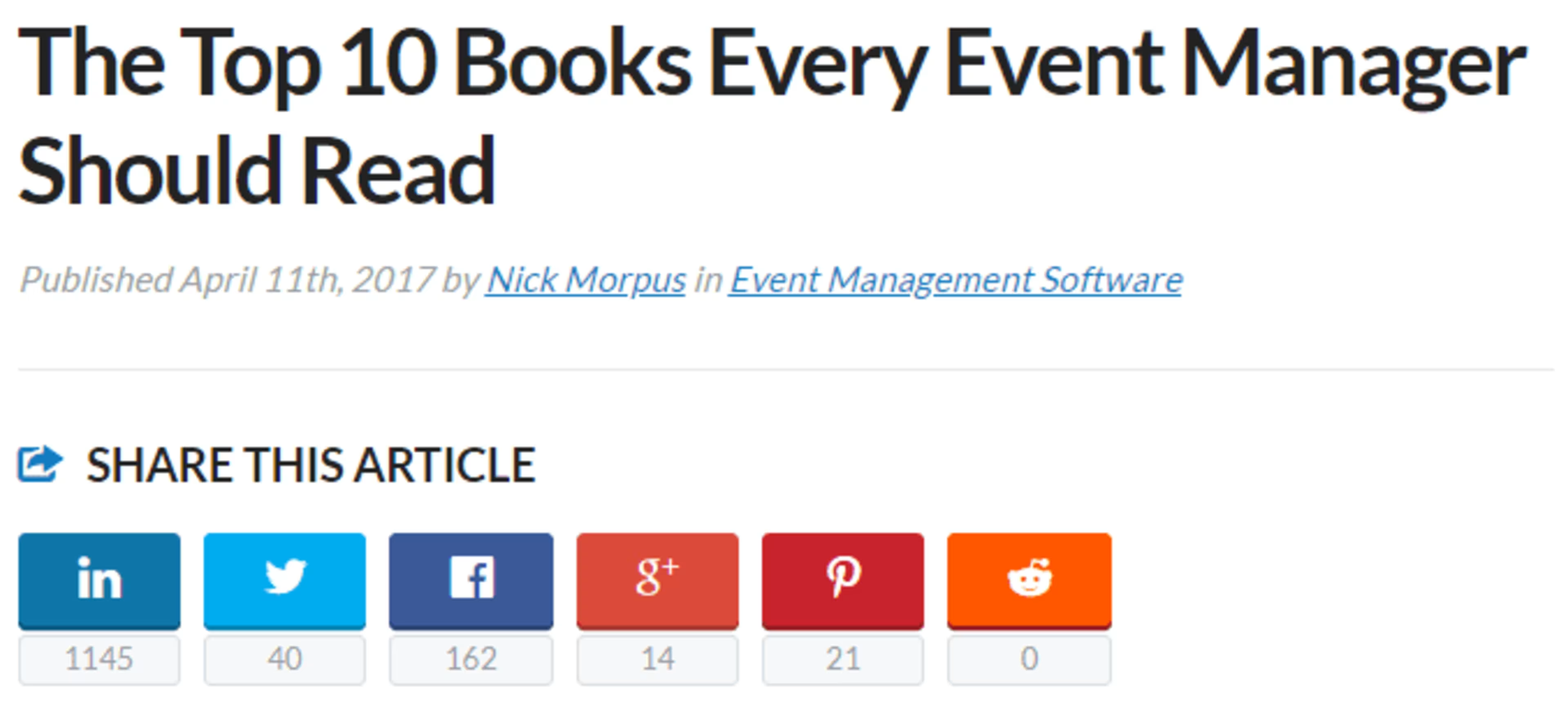
...he scores!
Which also did gangbusters.
At this point, we were pretty sure we had a winner on our hands, so we added, “The Top X Books for [Category Professional]" to our core topics list and started rolling it out elsewhere, and so far have seen similar levels of success.
But it doesn't end there.
We also make sure to update our top performing core pieces every six to 12 months and republish them (on the same URL, but with new internal content and a new publish date).
This allows us to keep the content relevant for readers as conditions change in the industry, but it also keeps the content fresh for Google so it continues to rank well.
You can see this in action in the graph below. Look at those step-function traffic increases after each update!

Traffic increases after pieces are updated—who knew making your content more helpful over time could lead to more readers?
And this brings us (finally) to our last big lesson learned.
Lesson 5: Keep at it
Everyone loves a good Cinderella story.
In the content marketing world, “Cinderella" is the blog with the quick ramp-up period, the breakout hit, and then the exponential, hockey-stick traffic growth.

Whoops, wrong fairy tale (Source)
Our experience has been decidedly less exciting, but, I suspect, far more common.
It took us five years of relentless, persistent, hard work to grow our blog traffic to a million monthly visitors.

Our traffic growth looks less like a hockey stick and more like a really boring line
That's a very slow build, but don't be fooled by the size of the graph—those flat-looking numbers back in January of 2014 were still around 13,000 monthly sessions, up from just 3,000 six months earlier.
It may not be as sexy as a hockey stick, but consistent, linear growth can still lead to prodigious results.
And it means you can have content marketing success without having to discover "the next best thing," or having a “viral" hit, or getting oodles of fawning tier one media exposure.
Of course, it also means you can't be flighty and change your strategy every two months, or chase every shiny new content fad. Instead, build on a solid, principled foundation first, and you can do the wackier stuff later.
Jimmy Daly over at the animalz.co blog (incidentally a fantastic resource for deep thoughts on content marketing strategy) distills this concept into maybe my favorite content marketing quote of all time:
"Great content is often silent."
Jimmy Daly, animalz.co
The slow build is still the king of content success. Keep at it, don't chase shiny things by constantly changing your strategy, and the compounding effect of all your great content will get you where you want to go.
It's not easy, but it is simple.
And that's it. Those are our big lessons.
Sorry for all the “Silicon Valley" gifs.
Need more help? Here are a few free bonuses to guide you
As promised above, I've put together bonus resources that you're totally free to steal and use for your own content program (yes, even you, our competitors—you're welcome).
Click here for the bonus resources, which include:
Our original, two-page content strategy doc
Our original, two-page promotion strategy
The promotion checklist our writers use for each of their pieces
The checklist we use to guide our quarterly topic planning
A printable worksheet to help you think through and outline your own content strategy
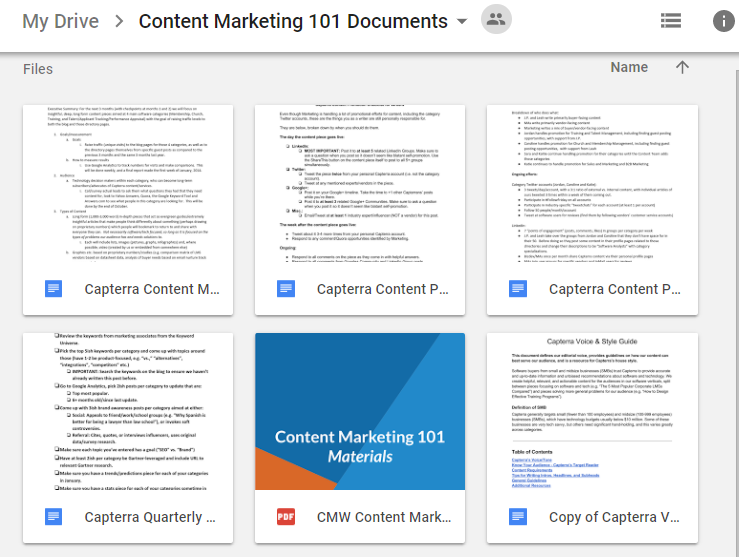
Here's a preview. I definitely stole this "bonus resource" idea from Bryan Harris of VideoFruit. He's a gem.
P.S. I'll be running a workshop on this very topic at Content Marketing World on Tuesday, September 4th, 2018, so sign up and we can talk shop in person! Use the promo code MEDVED to get $100 off the registration fee.